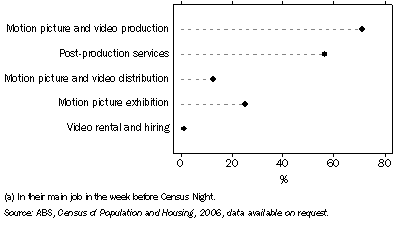EMPLOYMENT
Census of Population and Housing
The 2006 Census of Population and Housing collected employment data relating to the job in which a person worked the most hours during the week before the Census.
According to the Census, there were 8,900 people whose main job was in the Motion picture exhibition industry in August 2006. The Census also found that there were 7,364 people whose main job was in the Motion picture and video production industry, 898 people in Post-production services and other motion picture and video activities and 871 people in Motion picture and video distribution. Table 16.11 shows the top eight cultural occupations per industry. There are many other occupations involved in the film and video industry and these are grouped under Other cultural occupations and other occupations.
16.11 PERSONS EMPLOYED IN FILM AND VIDEO INDUSTRIES(a)(b), by occupation - August 2006 |
|  |
 |  | Number | % |  |
|  |
| Motion Picture and Video Production |  |  |  |
 | Media producer | 1 424 | 19.3 |  |
 | Director | 557 | 7.6 |  |
 | Film and video editor | 539 | 7.3 |  |
 | Video producer | 374 | 5.1 |  |
 | Production assistant | 341 | 4.6 |  |
 | Camera operator | 338 | 4.6 |  |
 | Other cultural occupations | 1 808 | 24.6 |  |
 | Total cultural occupations | 5 381 | 73.1 |  |
 | Other occupations | 1 983 | 26.9 |  |
 | Total occupations | 7 364 | 100.0 |  |
| Postproduction Services and Other Motion Picture and Video Activities |  |  |  |
 | Film and video editor | 136 | 15.1 |  |
 | Illustrator | 91 | 10.1 |  |
 | Media producer | 36 | 4.0 |  |
 | Graphic designer | 24 | 2.7 |  |
 | Performing arts technicians | 23 | 2.6 |  |
 | Sound technician | 17 | 1.9 |  |
 | Other cultural occupations | 188 | 20.9 |  |
 | Total cultural occupations | 515 | 57.3 |  |
 | Other occupations | 383 | 42.7 |  |
 | Total occupations | 898 | 100.0 |  |
| Motion Picture and Video Distribution |  |  |  |
 | Media producer | 22 | 2.5 |  |
 | Graphic designer | 11 | 1.3 |  |
 | Director | 12 | 1.4 |  |
 | Visual merchandiser | 10 | 1.1 |  |
 | Production assistant | 5 | - |  |
 | Librarian | 7 | 0.8 |  |
 | Other cultural occupations | 47 | 5.4 |  |
 | Total cultural occupations | 114 | 13.1 |  |
 | Other occupations | 757 | 86.9 |  |
 | Total occupations | 871 | 100.0 |  |
| Motion Picture Exhibition |  |  |  |
 | Motion picture projectionist | 869 | 9.8 |  |
 | Cinema or theatre manager | 868 | 9.8 |  |
 | Director | 59 | 0.7 |  |
 | Actor | 38 | 0.4 |  |
 | Light technician | 40 | 0.4 |  |
 | Sound technician | 35 | 0.4 |  |
 | Other cultural occupations | 349 | 3.9 |  |
 | Total cultural occupations | 2 258 | 25.4 |  |
 | Other occupations | 6 642 | 74.6 |  |
 | Total occupations | 8 900 | 100.0 |  |
|  |
| - nil or rounded to zero (including null cells) |
| (a) Cells in this table have been randomly adjusted to avoid the release of confidential data. |
| (b) In their main job in the week before Census Night. |
| Source: ABS, 2006 Census of Population and Housing, data available on request. |
Over half of those employed in the film and video industries (54%) worked in non-cultural occupations. The percentage of persons employed in cultural occupations varied considerably amongst the film and video industries - from 1.8% in the video rental and hire industry to 66.3% in the Motion picture and video production industry.
16.12 PERCENTAGE OF PERSONS EMPLOYED IN CULTURAL OCCUPATIONS(a),
By film and video industries - August 2006

Work Survey
The 2007 survey of Work in Selected Culture and Leisure Activities, reported that 117,700 people had a work involvement in either film production or cinema and video distribution in the 12 months to April 2007. Nearly two thirds of those involved in cinema and video distribution (64%) were paid for their work, as were just over one third (35%) of those involved in film production. Unlike the Census of Population and Housing, this survey collects more than just 'main job' activity. See Chapter 5 for more details on the differences between the data collections.
Service Industry Surveys
According to the 2002-03 ABS survey of Television Film and Video production, the number of employees in the film and video production business increased by an annual average of 2.6%, from 15,195 in June 2000 to 16,427 in June 2003.
When making comparisons between the various sources of employment data for this sector it is important to take into consideration the differing scope and reference periods of the respective surveys.
 Print Page
Print Page
 Print All
Print All